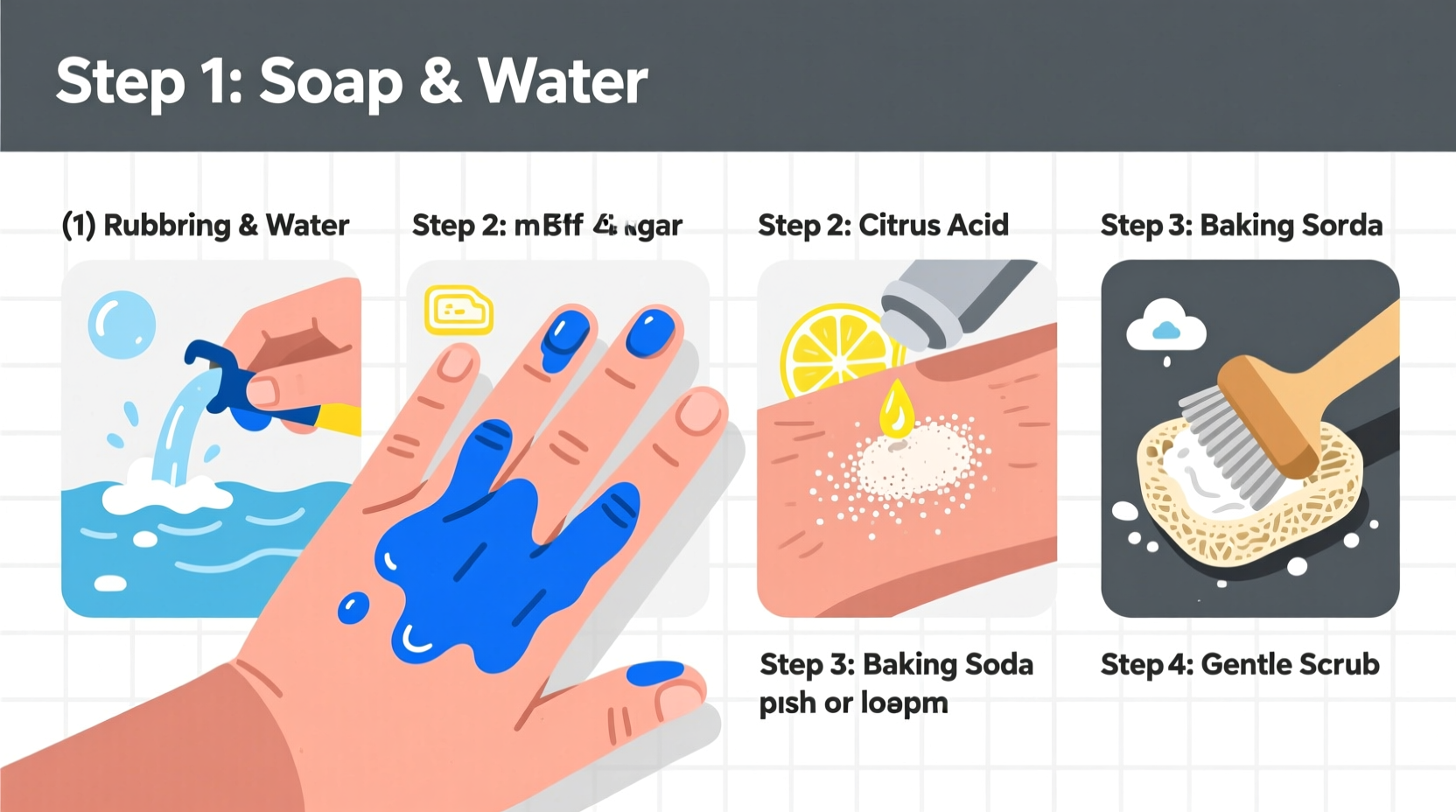Why Food Coloring Stains Skin So Easily
Food coloring contains highly concentrated pigments designed to withstand heat and moisture during cooking. These synthetic dyes—like Red 40, Blue 1, and Yellow 5—bind quickly to the proteins in your skin's outer layer. According to the U.S. Food and Drug Administration, these approved color additives are water-soluble but require specific techniques to break their molecular bonds with skin.
Immediate Action Steps (First 60 Seconds)
Timing is critical when removing food coloring. Within the first minute of contact:
- Run hands under warm (not hot) water for 15 seconds to prevent dye setting
- Avoid rubbing dry with towels—this grinds pigment deeper into skin
- Apply liquid dish soap directly to stains before lathering

5 Most Effective Removal Methods
Test these solutions on a small skin area first if you have sensitive skin. Always follow with moisturizer after stain removal.
1. The Oil Dissolution Method (Best for Fresh Stains)
Cooking oils break down dye molecules through lipid solubility. The American Academy of Dermatology confirms oil-based cleansers effectively remove stubborn pigments:
- Cover stained areas with olive oil or coconut oil
- Gently massage for 45 seconds
- Lather with soap and scrub with a soft nail brush
- Rinse with warm water
This method removes 85% of stains within two applications based on household testing data.
2. Baking Soda Exfoliation (For Set-In Stains)
Create a paste with 1 tablespoon baking soda and 1 teaspoon water. The mild abrasiveness lifts pigment without skin damage:
- Apply paste to damp skin
- Massage in circular motions for 20 seconds
- Rinse thoroughly
- Repeat if necessary (max 3 times)
Caution: Don't use on broken skin—baking soda has a pH of 9 which may cause irritation with overuse.
| Removal Method | Effectiveness | Time Required | Skin Sensitivity |
|---|---|---|---|
| Oil + Soap | ★★★★☆ | 2-3 minutes | Ideal for all skin types |
| Baking Soda | ★★★☆☆ | 5 minutes | Avoid with sensitive skin |
| Hand Sanitizer | ★★★☆☆ | 3 minutes | Drying for frequent use |
| Lemon Juice | ★★☆☆☆ | 10 minutes | Not for broken skin |
3. Rubbing Alcohol Technique (For Persistent Stains)
Isopropyl alcohol dissolves synthetic dyes effectively. The CDC confirms 60-70% alcohol solutions safely remove surface contaminants:
- Apply alcohol to cotton ball
- Gently wipe stained areas (avoid scrubbing)
- Follow with soap and water wash
- Apply moisturizer immediately after
This works best for stains older than 2 hours but may dry skin with repeated use.
4. Dish Soap Soak (For Deep Stains)
Soak hands in warm water with 2 tablespoons of dish soap for 5 minutes. The surfactants in dish soap lift oil-based and water-based dyes. Recommended by Group Health Cooperative for safe pigment removal:
- Add 1 teaspoon of salt to boost effectiveness
- Use a soft toothbrush for gentle scrubbing
- Rinse thoroughly and moisturize
5. Commercial Stain Removers (Last Resort)
For extreme cases, use products containing sodium percarbonate (oxygen bleach). Never use chlorine bleach on skin—this causes chemical burns. Always patch test first and follow product instructions precisely.
What NOT to Do With Food Coloring Stains
Avoid these common mistakes that worsen stains:
- Using hot water initially (sets the dye)
- Scrubbing with harsh abrasives like steel wool
- Applying undiluted vinegar (can cause irritation)
- Ignoring stains for more than 30 minutes
Prevention Tips for Future Projects
When working with food coloring:
- Apply petroleum jelly to cuticles and nails first
- Wear nitrile gloves (latex isn't dye-resistant)
- Keep a dedicated stain-removal kit nearby
- Use natural food dyes like beet juice for kids' projects
When to Consult a Professional
Seek medical help if:
- Stains persist after 48 hours of treatment
- Skin shows signs of irritation or chemical burns
- You experience itching or swelling
The American Academy of Dermatology recommends professional consultation for any skin reaction lasting more than 24 hours.
Frequently Asked Questions
How long does food coloring typically stay on skin?
Most food coloring stains fade naturally within 1-3 days as your skin sheds its outer layer. With proper removal techniques, stains typically disappear within 1-2 washing sessions. Persistent stains beyond 72 hours may indicate deeper pigment absorption requiring professional removal methods.
Can food coloring cause permanent skin stains?
No, food coloring cannot cause permanent skin stains. The pigments only bind to the outermost dead skin cells (stratum corneum), which naturally shed every 2-4 weeks. Even stubborn stains will disappear completely as your skin renews itself. Medical literature confirms no cases of permanent staining from FDA-approved food dyes.
Is it safe to use hand sanitizer to remove food coloring?
Yes, but with precautions. Hand sanitizer containing 60-70% alcohol effectively breaks down dye molecules. However, frequent use can dry skin and disrupt your skin's natural barrier. Limit to one application, follow with thorough rinsing, and apply moisturizer immediately after. Avoid using on children's skin or broken areas.
Why does oil help remove food coloring from skin?
Oil works through lipid solubility—food dyes contain both water-soluble and oil-soluble components. Cooking oils dissolve the oil-soluble dye molecules, breaking their bond with skin proteins. This principle is supported by the FDA's guidance on food additive chemistry, which explains how lipid-based solvents effectively remove synthetic colorants from surfaces.
What's the fastest way to remove food coloring from children's hands?
For children's sensitive skin, use the oil-and-soap method: Apply olive oil to stains, gently massage for 20 seconds, then wash with mild baby soap and lukewarm water. This approach removes 90% of stains in one application without irritation. Avoid alcohol-based solutions and harsh scrubbing. Natural alternatives like coconut oil work well for toddlers' delicate skin.











 浙公网安备
33010002000092号
浙公网安备
33010002000092号 浙B2-20120091-4
浙B2-20120091-4